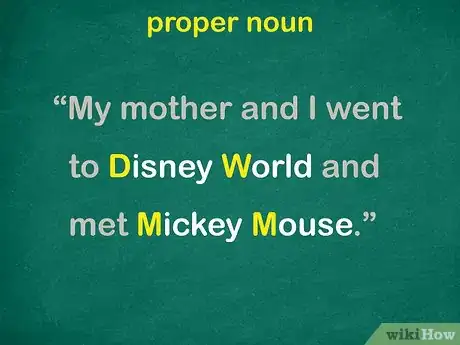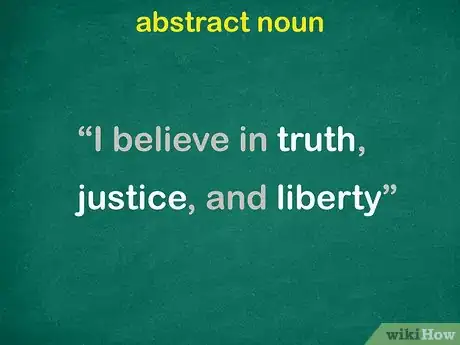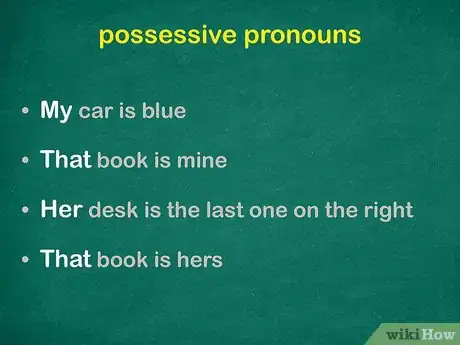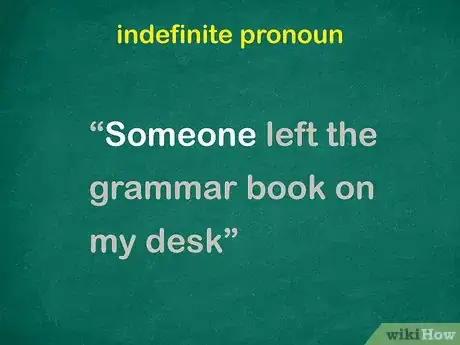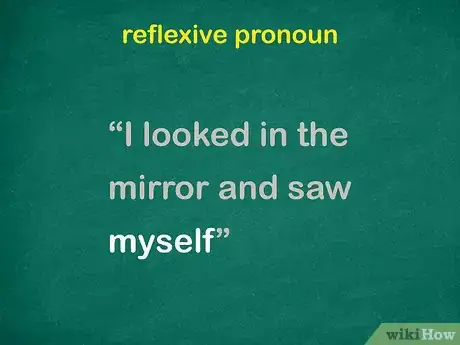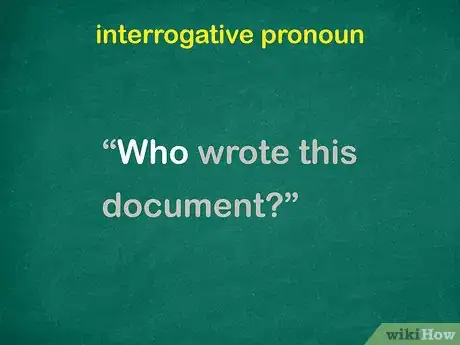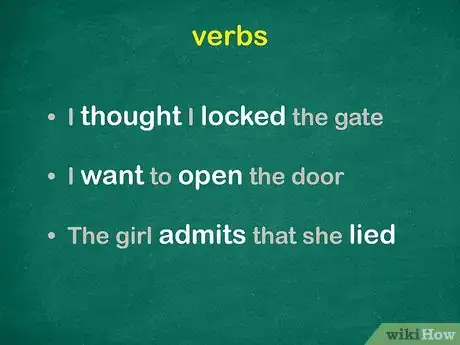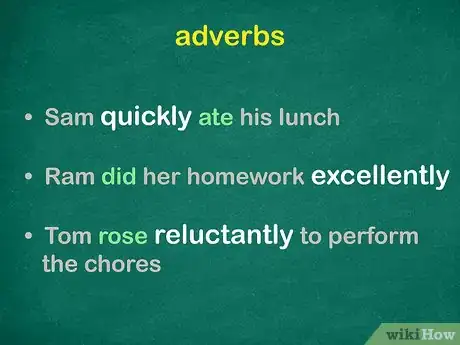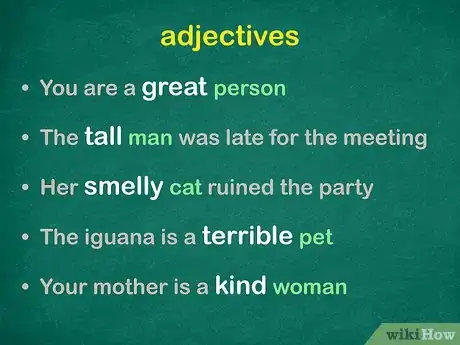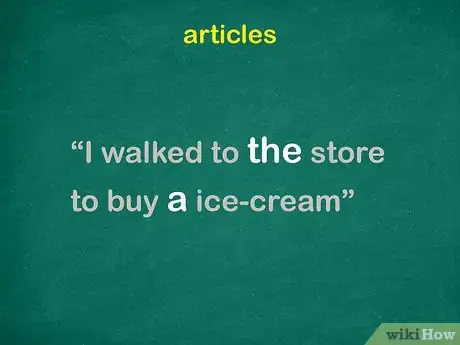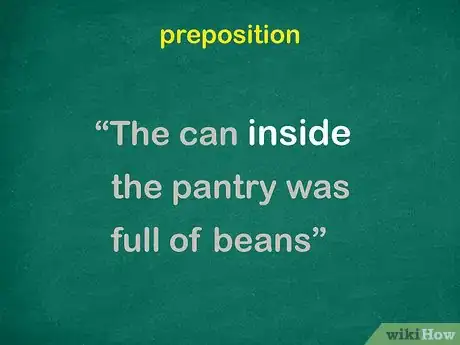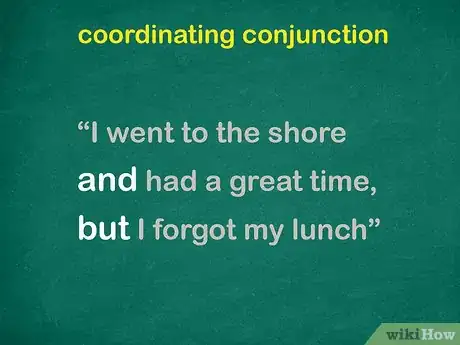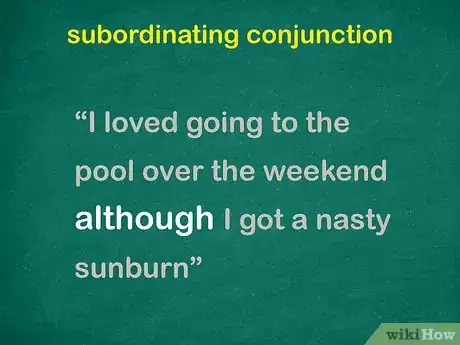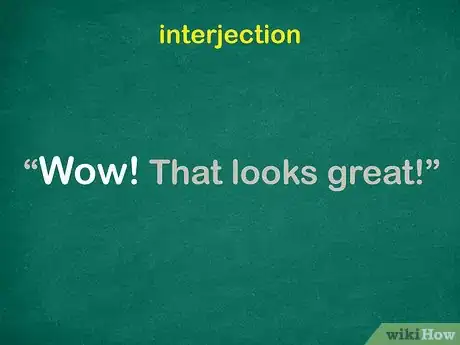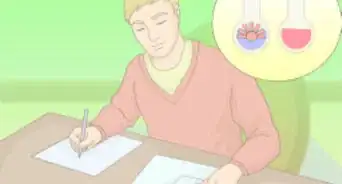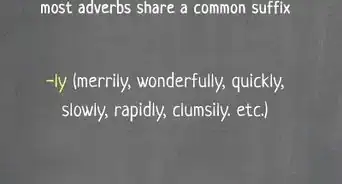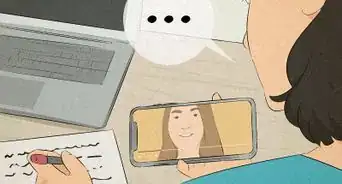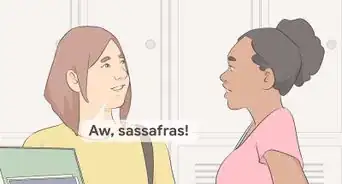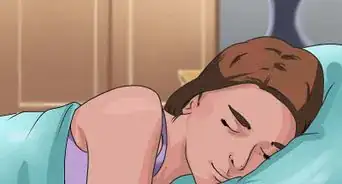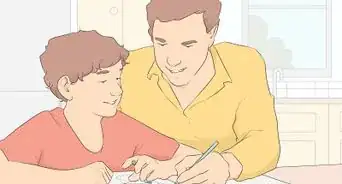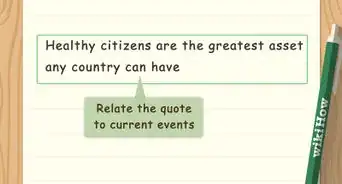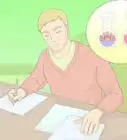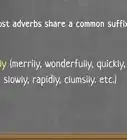This article was co-authored by Christopher Taylor, PhD. Christopher Taylor is an Adjunct Assistant Professor of English at Austin Community College in Texas. He received his PhD in English Literature and Medieval Studies from the University of Texas at Austin in 2014.
wikiHow marks an article as reader-approved once it receives enough positive feedback. In this case, 88% of readers who voted found the article helpful, earning it our reader-approved status.
This article has been viewed 114,196 times.
The vocabulary of the English language can be divided up into 8 parts of speech based on the function of different types of words. These types are: nouns, verbs, conjunctions, pronouns, prepositions, adverbs, adjectives, and interjections.[1] While most English users are capable of using all of these parts of speech, they may not fully understand what some categories of words do or how they’re technically used. Understanding the parts of speech can help you be a better speaker and writer of English.
Steps
Using Nouns and Pronouns
-
1Use nouns to represent people, places, things, and ideas. While there are different types of nouns, they all serve more or less the same function in a sentence: to denote an object, person, place, or abstract concept. Nouns are often used with articles (modifying words such as “the” or “a” that show whether a noun is specific or non-specific), but not necessarily in every instance.[2]
- Most nouns fall into the category of the common noun, i.e., nouns that refer to general people, places, and things rather than specific ones. For example, “man” and “mountain” are common nouns, while “Abraham Lincoln” and “Mount Rushmore” are proper nouns that refer to unique, specific entities.
- Not all nouns denote things that exist physically. Some refer to abstract ideas or broad concepts (e.g., “love,” “time,” or “justice”).
-
2Indicate whether the noun is singular, plural, or uncountable. With the addition of an “-s” or an “-es,” most singular nouns can be made plural. You can also indicate the number of a noun by using determining adjectives such as “a” (singular), “some” (plural), or a specific number (“forty-seven”).[3]
- For example, teacher is a singular noun, while calendars is a plural noun. Some nouns, like sheep, have the same form whether they are singular or plural.
- Some nouns are uncountable, and these are usually treated as neither singular nor plural (e.g., rice or money). These nouns are never used with singular articles like a or an.[4]
- Collective nouns may be treated as singular even if they refer to a group of people or objects. For example, “A family was at the table next to us.”
- Add "-es" to pluralize nouns ending with "s," "ch," "sh," "z," or "x." For example, the plural of box is boxes.
Advertisement -
3Capitalize proper nouns, which indicate specific persons or places. Proper nouns are always capitalized to indicate that you’re referring to a single, specific entity. Mr. Jones, Miami Beach, and Apple Computer are all examples of proper nouns.
- For example, you could say, “My mother and I went to Disney World and met Mickey Mouse.”
- Proper nouns include the names of people, places, and organizations.
-
4Represent concepts and other intangible objects with abstract nouns. Unlike concrete nouns, which signify tangible objects (e.g., rattlesnake), abstract nouns point to intangible ideas.[5] Some abstract nouns are honesty, love, and sadness. You can use abstract nouns to say something like: “I believe in truth, justice, and liberty.”
- Abstract nouns can also represent activities. Some examples include reading, writing, swimming, painting, and drawing.
-
5Introduce pronouns to take the place of nouns in a sentence. English speakers use personal pronouns all the time. Personal pronouns take the place of a specific person or thing (including the speaker themself) in a sentence.[6] There are several categories of pronouns: First person singular: I. First person plural: we. Second person singular: you. Second person plural: you. Third person singular: he, she, it. Third person plural: they. Examples of their usage include:
- I am eating pizza.
- We are going to the movies
- You study English 6 hours per week.
- We are going to El Salvador for vacation.
- He is my brother.
- She is my sister.
- It is big, dark, and dangerous.
-
6Know that possessive pronouns define ownership or show possession. Use a possessive pronoun if you want to show that an individual or group owns a specific object.[7] These pronouns fall into several categories. These are: first person singular (my, mine), first person plural (our, ours), second person singular (your, yours), second person plural (your, yours), third person singular (his, her, hers, its), and third person plural (their, theirs). Here are some examples of their use:
- My car is blue.
- That book is mine.
- Her desk is the last one on the right.
- That book is hers.
-
7Use demonstrative pronouns to draw attention to the noun that the pronoun is standing in for. There are 4 demonstrative pronouns broken into 2 categories: singular and plural. The singular demonstrative pronouns are “this” and “that.” The plural demonstrative pronouns are “these” and “those.” For example:
- This needs more memory.
- That is in the historical register.
- These are mine and those are yours.
- Are you wondering when you should use “this” and when you should use “that”? “This” (and “these”) are generally used to point to something closer in proximity while “that” (and “those”) points to something more distant.
-
8Realize that indefinite pronouns refer to nonspecific people. Here is an example: “Someone left the grammar book on my desk.” The indefinite pronoun “someone” indicates that, while a person left a book on your desk, you have no idea who it was.
- Indefinite pronouns include words like: one, someone, no one, nobody, anything, something, several, each, most, all, neither, either, another, other, both, many, few, any, some, something, and everyone.
-
9Use the reflexive pronouns to refer back to yourself. These pronouns point back to or reflect the subject of the sentence. Reflexive pronouns can also point back to another noun or pronoun within a sentence.[8] Some reflexive pronouns include: “myself” (first person singular), “yourself” (second person singular), “themself," "himself," and "herself" (third person singular), “ourselves” (first person plural), “yourselves” (second person plural), and “themselves” (third person plural). For example, you could say:
- I looked in the mirror and saw myself.
- She chided herself for not doing better on the exam.
-
10Use interrogative pronouns when asking questions. Interrogative pronouns are used as nouns in sentences that ask about a person. These sentences are almost always questions aimed at finding out the identity of a specific person. The interrogative pronouns are: who, which, what, whom, and whose.[9] Some examples are:
- Who wrote this document?
- Whose laptop is running Linux?
-
11Deploy a relative pronoun to define an object's relationship to a noun that you've already referred to. The relative pronoun relates back to a previous statement.[10] For example, in the sentence, “I met a woman who stole my heart,” who functions as a relative pronoun which relates back to “woman.” Who stole my heart? The woman I met.
- The relative pronouns are: who, whom, whose, what, which, that, whoever, whatever, and whomever.
Using Verbs, Adverbs, and Adjectives
-
1Deploy verbs to show that an action is being performed. Verbs show action or indicate a state of being.[11] As in other languages, verbs need to be conjugated to match the number of people performing them. You'll also need to put verbs in past, present, or future tense to indicate the time in which the action was performed. For example:
- In the sentence, “I thought I locked the gate,” thought and locked are both past-tense verbs.
- In the sentence, "I want to open the door," want and open are both present-tense verbs.
- In the sentence, "The girls admit they lied," admit is in its plural form. Were you only talking about 1 girl, you would say, "The girl admits that she lied."
-
2Use adverbs to modify a verb in a sentence. An adverb describes an action or an adjective (or another adverb in some cases). Adverbs show when, to what extent, and how a specific action was performed.[12] Most, but not all adverbs end with “-ly.” Examples of adverbs include:
- How: “Sam quickly ate his lunch,” or “Bertram moodily shaved his mustache.”
- To what extent: “Jennie did her homework excellently,” or “The cat was very furry.”
- When: “Tom went to his lessons weekly,” or “Adele never cut her hair.”
- The “-ly” ending is usually used for adverbs that derive from adjectives (such as “hungrily” from “hungry” or “gently” from “gentle”). Adverbs that do not follow this form include “too,” “very,” “never,” and “often.”
-
3Insert adjectives to modify and add information to nouns. You can use adjectives to modify nouns and, occasionally, pronouns. These words answer questions about nouns like: what kind? which one? how many?[13] Examples of adjectives include:
- You are a great person.
- The tall man was late for the meeting.
- Her smelly cat ruined the house party.
- The iguana is a terrible pet.
- Your mother is a kind woman.
- When adjectives are used to modify pronouns, they usually need a helping verb such as is and are. For example, “They are interesting,” or “He is tall.”
- In rare cases, adjective forms can be used to modify another adjective (a job that is typically done by adverbs). For example, “He drove a bright red car.”
-
4Use articles and other determiners to introduce and define nouns. Determiners are a special form of adjective that are used to provide information about nouns, such as specificity, number, and distance from the speaker. For example, if you want to indicate specificity, use a definite or indefinite article. You would use the definite article “the” when you're referring to 1 particular example of a specific noun (e.g., “the book”). Use “a” if you're referring to any example of a that kind of noun (“a book”).[14] The most common types of determiners include:
- The definite article the (singular or plural) and the indefinite articles a or an (singular) or some (plural). These articles show whether the noun they modify is specific or general. For example, “The [specific] man wanted some [general] apples.”
- The demonstrative adjectives, which indicate both specificity and proximity to the speaker. This (singular) and these (plural) refer to specific nouns that are close to the speaker. That (singular) and those (plural) suggest a little more distance. For example: “Put these [specific, close] books with those [specific, more distant] papers over there.”
- Numbers are also a form of determiner, which can specify the quantity of a noun. For example, “I have twenty-three cats in my bedroom!”
Writing Prepositions and Conjunctions
-
1Use prepositions to clarify the relationship between 2 or more objects. A preposition is a word joined with (and generally placed before) a noun or its equivalent. The preposition, together with the noun, forms a phrase equivalent to an adverb or adjective. Use prepositions to add more information about a noun in the sentence. Prepositions include words like: at, with, by, in, above, below, beside, and outside.[15]
- So, you could write something like, “The can inside the pantry was full of beans.”
- Or, “Take life by the horns or it will run you over.”
-
2Add coordinating conjunctions to join 2 clauses or phrases together. A conjunction is a word that joins sentences, clauses, or words and allows them to stay together in a single sentence. Examples of commonly used coordinating conjunctions include: and, or, but, and for. Coordinating conjunctions give the 2 clauses or parts of a sentence equal priority or importance.
- So, you could write something like, “I went to the shore and had a great time, but I forgot my lunch.”
-
3Deploy a subordinating conjunction to establish a hierarchy between clauses. Unlike coordinating conjunctions, subordinating conjunctions downplay the importance of the second clause in a compound sentence. Subordinating clauses include words like: because, while, since, and although.[16]
- “I hoped that I would not be late for school because I knew we would have a test today.”
- “I loved going to the pool over the weekend although I got a nasty sunburn.”
-
4Insert interjections to express surprise, anger, or pleasure. An interjection is a word thrown into a sentence to express a feeling. Interjections have no grammatical relation to the rest of the words in the sentence. For this reason, they're most commonly placed at the beginning or end of a sentence.[17] Examples of commonly used interjections include:
- Wow!
- Ouch!
- Oh no!
- Yay!
Community Q&A
-
QuestionWhat are the differences between adverbs and verbs?
 Community AnswerA verb is an action word and tells the reader what is happening. For example, in the sentence "Jane ran," the word "ran" is a verb. An adverb modifies or describes a verb. For example, in the sentence "Jane ran quickly," the word "quickly" is an adverb because it describes how Jane "ran."
Community AnswerA verb is an action word and tells the reader what is happening. For example, in the sentence "Jane ran," the word "ran" is a verb. An adverb modifies or describes a verb. For example, in the sentence "Jane ran quickly," the word "quickly" is an adverb because it describes how Jane "ran." -
QuestionWhy do I have to use prepositions?
 Community AnswerPrepositions state a relationship of something to something else. For example, in the sentence "Sam stood on the bridge", the word "on" is the preposition. It tells you where Sam was compared to where the bridge was.
Community AnswerPrepositions state a relationship of something to something else. For example, in the sentence "Sam stood on the bridge", the word "on" is the preposition. It tells you where Sam was compared to where the bridge was. -
QuestionI need to learn more about prepositions. Where can I go?
 Community AnswerSeveral websites can help. For example, you can visit the Khan Academy website or Google the Schoolhouse Rock video on prepositions. Numerous blogs also contain thorough explanations.
Community AnswerSeveral websites can help. For example, you can visit the Khan Academy website or Google the Schoolhouse Rock video on prepositions. Numerous blogs also contain thorough explanations.
References
- ↑ http://www.butte.edu/departments/cas/tipsheets/grammar/parts_of_speech.html
- ↑ http://www.butte.edu/departments/cas/tipsheets/grammar/parts_of_speech.html
- ↑ https://en.oxforddictionaries.com/grammar/types-of-noun
- ↑ https://en.oxforddictionaries.com/grammar/countable-nouns
- ↑ http://www.butte.edu/departments/cas/tipsheets/grammar/parts_of_speech.html
- ↑ http://www.butte.edu/departments/cas/tipsheets/grammar/parts_of_speech.html
- ↑ http://www.butte.edu/departments/cas/tipsheets/grammar/parts_of_speech.html
- ↑ http://www.butte.edu/departments/cas/tipsheets/grammar/parts_of_speech.html
- ↑ https://www.aresearchguide.com/parts-of-speech.html
- ↑ http://www.butte.edu/departments/cas/tipsheets/grammar/relative_pronouns.html
- ↑ https://www.englishclub.com/grammar/parts-of-speech.htm
- ↑ http://www.butte.edu/departments/cas/tipsheets/grammar/parts_of_speech.html
- ↑ http://www.butte.edu/departments/cas/tipsheets/grammar/parts_of_speech.html
- ↑ http://www.butte.edu/departments/cas/tipsheets/grammar/parts_of_speech.html
- ↑ http://www.butte.edu/departments/cas/tipsheets/grammar/parts_of_speech.html
- ↑ http://www.butte.edu/departments/cas/tipsheets/grammar/parts_of_speech.html
- ↑ http://www.butte.edu/departments/cas/tipsheets/grammar/parts_of_speech.html

